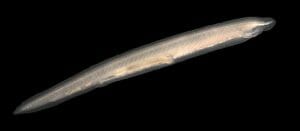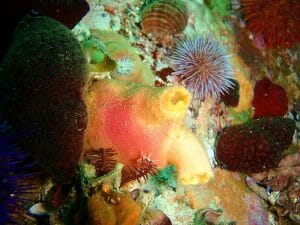Chordate Definition
A chordate is an animal that belongs to the phylum Chordata, which is part of the Deuterostomes kingdom. Organisms in the Deuterostomes kingdom have a distinct characteristic: their anus develops before their mouth in early embryonic stages. The phylum Chordata includes a wide range of organisms, as it is comprised of all vertebrates, which are organisms with a backbone, and many invertebrates; organisms that don’t have a backbone. There are three subphyla to Chordata: Cepahlochordata, Urochordata, and Vertebrata. Chordates generally have bilaterally symmetric bodies, though a few exceptions exist, and they share distinct characteristics that will be discussed later on.
Characteristics of Chordates
Chordates have all of these characteristics, at least at some point in their lives. In many cases, these characteristics only appear during embryonic development.
Pharyngeal Slit
In invertebrates, this is used in feeding as a filter, while in vertebrate fish, it develops into gill arches, the function of which is to support gills. Human embryos have gillslits, but they disappear before we are born and the tissue develops into other structures in the head and neck. Generally, the tissue is modified for various purposes in terrestrial vertebrates, such as for the jaws and the Eustachian tube connecting the ear to the throat.
Dorsal Hollow Nerve Cord
This is a tube made of nerve fibers that develop into the central nervous system, consisting of the brain and spinal cord, in vertebrates. This nerve cord is protected by the vertebrae, which are the bones that make up our backbone. What makes chordates different is that, in non-chordates, the nerve cords are solid and are either ventral or lateral within the body.
Notochord
This flexible skeletal rod that’s made of cartilage is what gives chordates their name. The notochord runs between an animal’s digestive tube and its nerve cord and provides support for the body. It is the precursor of a backbone, or spine, in vertebrates.
Post-Anal Tail
This is a posterior elongation of the body that helps propel aquatic animals in water, provides balance, and is used by some terrestrial vertebrates to attract mates and signal when danger is near. This tail shrinks in humans and other apes into a tailbone during embryonic development.
Subphyla of Chordates
Subphylum Vertebrata
This is the subphylum that we, and all other vertebrates, belong in. Vertebrata is often referred to as Craniata because the organisms in this subphylum have a head with a protective cranium, which most of us call a skull. Vertebrates also have a brain encased in the skull, highly developed internal organs, a closed circulatory system, and unique sensory and motor cranial nerves. Fish, amphibians, reptiles, mammals, and birds are all part of his subphylum, and thanks to the presence of bone or cartilage, their fossils are easily found.
Subphylum Cephalochordata
This literally means “head cords”. Cephalochordates are also called Lancelets, and they are filter-feeding marine animals with elongated, small, segmented, and soft bodies that make it difficult to find their fossils. They are usually found in soft bottoms as they bury themselves in the substrate, exposing their anterior part only (near the head) and using a row of tentacles to bring food into their mouth. Cephalochordates resemble fish, as we can see in the picture below, and swim like them, but they have no scales, backbone, limbs, or brain. They outdo fish, however, in the number of pharyngeal gill slits that they have.

Subphylum Urochordata
Meaning “tail cords”, these are also called Tunicates. This is another subphylum whose organisms’ fossils are difficult to find, since the bodies have no hard parts. It includes sea squirts and sea salps. These are barrel-shaped, non-segmented filter-feeding marine animals. The larval stage usually has a tail and is free-swimming, but it eventually attaches to a hard substrate and loses the tail as it transforms into the adult form. By the time these organisms are adults, they only display one characteristic of chordates, and that is pharyngeal gill slits.
Examples of Chordates
Lampreys
The lamprey is a chordate that belongs to the subphylum vertebrata. It is a jawless fish that lives as a filter-feeder in its many larval years, then transforms into a parasitic adult that has an oral disk filled with teeth that it uses to latch onto other fish. Note, however, that some adults don’t feed but rather live off reserves that they obtained as larvae. The adult has external gill slits for breathing, a cartilaginous skeleton, a nerve cord and a notochord. Larval lampreys use a mucus-secreting organ for trapping food particles in their pharynx, and have a post-anal tail. A lamprey larva is shown below.

Sea Squirts
The sea squirt is an Urochordate, or Tunicate. As we can see in the picture below, its body is barrel-shaped and is attached to the substrate. The larvae, which are tadpole-like, possess a notochord, a dorsal nerve, pharyngeal slits, and a post-anal tail. The adults are filter-feeders, having two openings, called the siphons. The siphons are used in filter-feeding by drawing water into one side and straining the phytoplankton, which is the sea squirt’s food source, then pumping out the filtered water through the other siphon.

These two examples are of relatively simple and small organisms, but remember that the phylum Chordata comprises a wide variety of animals. It’s amazing that such small animals can share a significant amount of characteristics with birds, mammals and plenty of other animals.
Related Biology Terms
- Filter-feeding – A feeding technique where surrounding water is filtered to extract tiny food particles.
- Phylum – A category used to group similar organisms together. Classes are grouped into phyla, and phyla are grouped into kingdoms.
- Hemichordata – A phylum made up of soft-bodied marine invertebrates that are found in a wide range of habitats. They have gillslits but lack a notochord.
Quiz
1. What’s the function of a notochord?
A. Provides energy
B. Helps chordates absorb food particles
C. Provides support for the body
D. Allows aquatic animals to move through water
2. Chordates are different from non-chordates as chordates have:
A. No nerve cord
B. A dorsal nerve cord
C. A ventral nerve cord
D. A heart
3. An animal in the subphylum vertebrata is also called a craniate because:
A. It has teeth
B. It feeds on other animals
C. It has a skull
D. It feeds on both plants an animals
